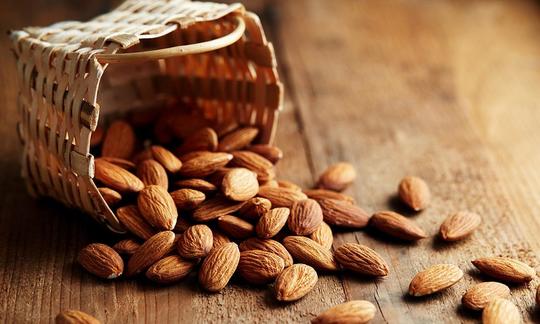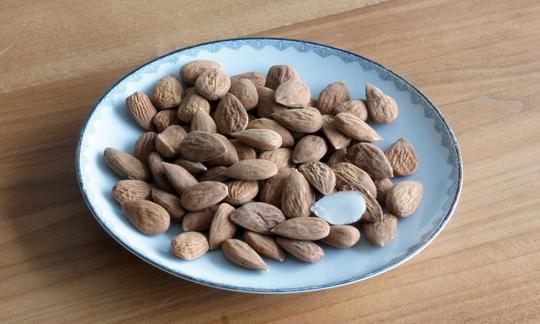Table of contents
Sweet almonds or almonds ( Prunus dulcis var. dulcis) are the fruits of the almond tree and have a wide range of uses. Examples include use as a baking ingredient, for eating raw, for making roasted almonds or almond oil.
Use in the kitchen:
Raw almonds provide valuable ingredients. They are ideal as a snack, in muesli ( pea muesli), in salads or ground in homemade power balls or muesli bars.
Cooked or blanched, they are used for decoration in the form of splinters or leaves, for filling olives or as marzipan. Roasted almonds are made with sugar and cinnamon ; they are very popular in the run-up to Christmas. Almond liqueur is made from almonds, apricot and peach kernels. Originally it was refined with the taste of bitter almonds.
In addition to its use in cosmetics, almond oil can also be used as cooking oil. It is suitable as an oil in salads or for preparing desserts.
Almond flour is a by-product of almond oil production. The press cake must be finely ground to produce deoiled almond flour. This flour is a good choice for people with gluten intolerance or celiac disease. However, due to the lack of gluten, its baking properties are very different from those of wheat. It is ideal for pizza or cake bases, cookies or flat rolls.
Raw almonds can also be processed into almond milk, almond puree or almond cream. Roasted almonds also taste good as almond butter without salt. Marzipan is a sweet made from blanched, peeled almonds, sugar and flavourings.
"April almonds" are unripe, green almonds that are prepared with the shell on, raw or cooked like vegetables. 1
As a guideline: 33 soaked almonds weigh about 50 g. If the kernels are not soaked, one almond weighs almost exactly 1 g (50 pieces make 50 g).
Recipe for vegan almond cream:
Soak 100 g of almonds in enough water for at least 8 hours. Then pour off the water and wash the almonds again briefly. Put the soaked almonds in a high-performance blender with 140 ml of water and 60 ml of oil (e.g. rapeseed oil) and mix for about 2 minutes until creamy. Pour this cream into a clean glass and leave it in the fridge for 1-2 days. It will keep for up to 10 days at 4 °C. It serves as a base for sauces, desserts or spreads.
| Not only vegans or vegetarians should read this: Vegans often eat unhealthily. Avoidable nutritional mistakes. |
Shopping - where to buy?
You can buy sweet almonds at all supermarket chains such as Coop, Migros, Denner, Volg, Spar, Aldi, Lidl, Rewe, Edeka, Hofer etc. Some also offer almonds in organic quality. In the run-up to Christmas, you can usually get almonds in all possible varieties: raw, roasted, salted, peeled, as flakes or as slivers.
Almond flour is only found in health food stores, organic shops or online retailers. In order to keep the pollutant content low, organic, sustainable cultivation is preferable when buying almond products.
Found in the wild:
The bitter almond ( Prunus dulcis var. amara) is the wild form of the sweet almond. The almond tree grows wild from the eastern Mediterranean through Anatolia to Uzbekistan. However, wild and feral occurrences can hardly be distinguished anymore. 2
Storage:
Almonds must always be stored in a dry, cool, dark place and protected from pests. At optimal temperatures of around 4.5 °C and a humidity of less than 65%, almonds can be stored for up to 2 years.
Ingredients - nutritional value - calories:
Almonds have a very high calorie content of 579 kcal/100 g. 50% of the energy comes from fat. Although the fat is predominantly unsaturated fatty acids, the ratio of LA:ALA (omega-6 to omega-3 fatty acids) is not particularly good: 548:1 - this value is even worse than for cashew nuts (up to 103:1). Read more about this under the ingredient cashew nuts, raw? organic? and in the box link above.
The protein contained makes up 21% and is made up of essential amino acids such as tryptophan, phenylalanine, threonine, etc. Valuable energy in almonds also comes from the carbohydrates (22%), of which 12% is fiber. 3
Almonds also score points with their vitamin and mineral content. Sweet almonds contain a lot of fat-soluble vitamin E : 26 mg/100g. Comparable unprocessed foods with a higher value of this important antioxidant are sunflower seeds with 35 mg or raw hemp seeds with 90 mg/100g. 3
It is similar with vitamin B2 (riboflavin) : almonds have 1.1 mg/100 g of this, and raw Muscat grapes have 1.5 mg, of which 100 g cover the daily requirement. 3
The essential trace element manganese is present in large quantities in most nuts and seeds. At 2.2 mg/100 g, almonds have a similar amount of manganese to black mustard (2.1 mg) or sesame (2.4 mg). Wheat germ, on the other hand, has a very high manganese content of 9-10 mg/100 g. 3
100 g of sweet almonds provide the body with 270 mg of magnesium. This impressive amount covers around 72% of the daily requirement. Magnesium is mainly found in seeds, nuts, whole grains, legumes and green vegetables. The essential element is water-soluble, which is why much of it is lost through soaking or cooking. If possible, the foods should be eaten raw. Cashew nuts (290 mg), sunflower seeds (325 mg), linseed (390 mg) and hemp seeds (900 mg) provide even more magnesium. 3
Almonds also contain a lot of phosphorus : 100 g contain 481 mg. Almost all foods contain phosphorus, but protein-rich seeds, nuts, pulses and grains in particular contain large amounts. Pistachios (490 mg) and wheat (493 mg) have similar values. 100 g of protein-rich soybeans cover the daily requirement with 734 mg of phosphorus. 3
You often read that almonds are a good source of iron : they provide 3.7 mg/100 g, which is actually not that much. Sesame seeds (15 mg) or unpeeled hemp seeds (8 mg) contain much more. Many types of grain or grain-like foods also have significantly higher values: amaranth (7.6 mg/100 g) and chia (7.7 mg/100 g). If you include almonds in your daily diet, they definitely help to replenish iron stores. In addition, a small amount of vitamin C (e.g. some fruit) is beneficial for improved iron absorption. 3
Health aspects - effects:
Do almonds make you fat? Although almonds have a high fat and carbohydrate content, they are not fattening. They keep you full for a long time and, if eaten regularly, even reduce your appetite for readily available carbohydrates. 4
"Superfood" almonds: Regular consumption of almonds and other nuts has many benefits, including improving blood lipid levels and thus helping to combat cardiovascular diseases. 5,6
Almonds regulate blood sugar levels, on the one hand they prevent a rapid drop in blood sugar levels after eating and on the other hand they counteract excessive insulin accumulation in the blood (insulinemia). The study cited refers to the measurement of lower oxidative damage to lipids and proteins. Almonds provide many antioxidants, which can subsequently prevent cardiovascular diseases. 7
Eating 20 g of almonds daily can cut the risk of heart disease by half. Almonds also lower blood pressure and cholesterol. 8
The folic acid contained in almonds (44 µg/100 g) can help pregnant women and nursing mothers to meet their increased folic acid requirements through their diet. Every woman should be aware that she needs more folic acid than normal even before pregnancy (450-550 µg daily). 9
Some types of grain, pulses and nuts store phosphate in the form of phytic acid. It can bind certain minerals such as calcium and magnesium, but also iron and zinc in an insoluble manner. If you soak foods with a high phytic acid content beforehand, you can reduce this acid. Read the following text: Phytic acid or phytate and soaking or sprouting.
The optimal soaking time for almonds is 4 hours. Soaking is recommended if you are using a large amount of almonds (e.g. for a raw food cake, nut sauces). If you are using small amounts and just a few pieces per day, you do not need to soak almonds.
Dangers - Intolerances - Side effects:
Are almonds poisonous? Sweet almonds can be eaten raw without any problems. However, caution is advised with bitter almonds due to the poison amygdalin. Amygdalin is a cyanogenic glycoside that the body converts into hydrogen cyanide using its own enzymes in the stomach. Children are even less well tolerated by this ingredient than adults. Depending on body weight, around 5-10 uncooked bitter almonds in children and 50-60 uncooked bitter almonds in adults can lead to fatal hydrogen cyanide poisoning. However, the hydrogen cyanide in bitter almonds can be rendered harmless by heating them.
People with allergies should be careful when eating almonds, as they can cause similar reactions to nuts. People who are allergic to nuts should also be careful with almonds.
Since small children often cannot bite the hard almond kernel, there is a risk that they will swallow it whole. This can lead to life-threatening respiratory distress.
Folk medicine - naturopathy:
In natural medicine, almonds are used internally and externally for many skin diseases. Almonds and almond oil are also said to make healthy skin shine even more beautifully and improve tolerance to UV rays. 10
Occurrence - Origin:
The origin of the almond tree ( Prunus dulcis) is probably in Southwest Asia. In the 5th or 6th century BC, the Greeks introduced the almond tree to Europe and it came to the Alpine region via the Romans.
In Germany, too, almond trees were planted commercially in wine-growing climate zones until around 1940. They specialized in cracked almonds ( Prunus dulcis var. fragilis), which are easier to crack. 11 In the German Palatinate, almond cultivation is once again being practiced today.
In 2017, according to FAO statistics, the main almond producers were the USA, Spain, Morocco, Iran, Turkey and Italy.
Growing in the garden or as a potted plant:
Where and how does an almond grow? The almond tree loves sunny slopes and stony soil. Sweet almonds grow between 700 and 1700 m above sea level. Almond trees reach a height of around 3 to 8 m and, depending on the variety, can form a spreading crown. 12
The following varieties are suitable for cooler climates: Dürkheimer Krachmandel, Lauranne and Robijn. If you do plant southern varieties, they should be kept protected indoors over the winter until the fourth year, after which they can be planted outdoors in the ground. 13
Also popular is the ornamental almond ( Prunus triloba) with its beautiful, delicate pink flowers.
Cultivation - Harvest:
From a botanical point of view, almonds are stone fruits, because they are the kernels of a fruit. The flowers are also very similar to those of the fruit trees we know.
When do the almond trees bloom? The flowering period varies depending on the region. In Mallorca they bloom from mid-January to mid-February and are considered a harbinger of spring.
A Mediterranean climate is best suited to almond trees. Warm, long and dry summer days are ideal. Almond trees are hardy, but the flowers only tolerate light spring frosts. The soil should be permeable, rich in humus and nutrients and able to store water well. The almond tree does not tolerate waterlogging. You will only benefit from the fruits of the almond tree from the fourth year onwards.
When it comes to professional almond cultivation, the choice of variety plays a very important role in terms of the hardness of the shell. How easy the almonds are to blanch is also very important for industrial processing. Generally speaking, European almonds have a harder shell than American ones.
During the traditional almond harvest at the beginning of September, the almond trees are shaken using iron rods or harvest shakers until the almonds fall into spread-out collecting nets. The almonds are separated mechanically from the branches and leaves that have also fallen. The almond kernels are usually opened mechanically as well.
Unfortunately, there are always years with poor yields (eg on Mallorca), which means that the trees are not harvested. The fruit falls to the ground and is used as food for the animals. However, this poor care leads to weaker harvests in subsequent years and the trees die after 3-4 years. 14 In addition, growing almonds requires a lot of water, which is always a bigger problem in dry areas.
Danger of confusion:
Occasionally, almond trees bear bitter almonds. Externally, they are very difficult to distinguish from sweet almonds. However, bitter almonds can be recognized immediately by their extremely bitter taste, which usually prevents poisoning.
General information:
Cultivated almonds or edible almonds ( Prunus dulcis) belong to the rose family (Rosaceae) within the tribe of stone fruit plants (Amygdaleae). The almond tree is also known by the synonyms Amygdalus communis L. or Prunus amygdalus Batsch.
According to Wikipedia, these three varieties are the most popular 1 :
- The sweet almond ( Prunus dulcis var. dulcis) has a sweet-tasting kernel and a hard shell, which is why it is also called stone almond.
- The cracked almond ( Prunus dulcis var. fragilis) also tastes sweet, the shell is fragile and can often be broken open by hand.
- The bitter almond ( Prunus dulcis var. amara) is slightly smaller than the sweet almond. It has a very bitter kernel and a hard shell. The bitter almond is poisonous.
In English, sweet almonds are called "almonds" and the tree is called "almond tree". In Spanish, they are called "almendras".
In Hebrew, the almond is called "guardian" or "watchman" because of its early flowering.
Literature - Sources:
Bibliography - 14 Sources
| 1. | Wikipedia Mandelbaum. |
| 2. | Browicz K. Concept and chorology of the genera Amygdalus L. and Louiseania Carrière. Arboretum Kórnickie. Band 34. 1991. |
| 3. | USDA United States Department of Agriculture. |
| 4. | Dhillon J. The effects of including almonds in an energy-restricted diet on weight, body composition, visceral adipose tissue, blood pressure and cognitive function. Purdue University. Diss. 2016. |
| 5. | Musa-Veloso K, Paulionis L, Poon T, et al. The effects of almond consumption on fasting blood lipid levels: a systematic review and meta-analysis of randomised controlled trials. J Nutr Sci. 2016;5:e34. |
| 6. | Hu FB, Stampfer MJ. Nut consumption and risk of coronary heart disease: A review of epidemiologic evidence. Current Atherosclerosis Reports. 1999;3. |
| 7. | Jenkins DJ, Kendall CW, Josse AR, et al. Almonds decrease postprandial glycemia, insulinemia, and oxidative damage in healthy individuals. J Nutr. 2006;136(12). |
| 8. | Choudhury K, Griffiths JC and HR. An almond-enriched diet increases plasma α-tocopherol and improves vascular function but does not affect oxidative stress markers or lipid levesl. Free Radical Research. 2014. |
| 9. | Saussele T. Supplementation with folic acid before and during pregnancy. Med Monatsschr Pharm. 2008;31(12). |
| 10. | Sultana Y, Kohli K, Athar M, et al. Effect of pre-treatment of almond oil on ultraviolet B-induced cutaneous photoaging in mice. J Cosmet Dermatol. 2007;6(1). |
| 11. | Historische Obstsorten Pfalz-Elsass-Kurpfalz. Süssmandel "Dürkheimer Krachmandel". 2013. |
| 12. | Scholz H, Scholz I. Prunus. Hildemar Scholz (Hrsg.). Illustrierte Flora von Mitteleuropa. Begründet von Gustav Hegi. 2. Auflage. Band IV Teil 2B: Spermatophyta: Angiospermae: Dicotyledones 2 (3) (Rosaceae, 2. Teil). Blackwell: Berlin/Wien u.a. 1995. |
| 13. | Gartenjournal.net Bitter bis süss: Der Mandelbaum und seine Sorten. |
| 14. | Gartenjournal.net Mandelernte. |















Comments